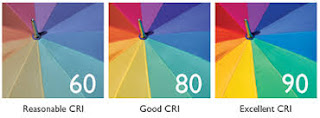Fundamentals of Glare
Glare
In simplistic terms, glare is any light source either direct
or reflected that reduces short term or long term visual performance. It is the
equivalent of noise in an audio system.
Glare results from an extremely complex set of interactions
between the lighting, both electric and natural, the surroundings and the
visual system of the body. Although there is a general understanding of the mechanism of glare and some algorithms for
prediction of glare, the prediction of the models often, do not agree with the
perception of the occupants.
The fact that glare cannot be reliably calculated does not diminish its
detrimental effect on the visual environment, nor its need to be addressed in
the design process.
At the same time it is not sufficient in designing a lighting
installation to say that, as glare is bad, we should minimise it as much as
possible. There have been many disastrous installations predicated on this
philosophy. Many attempts to eliminate glare have resulted in bland spaces that
lack visual interest, sparkle, and areas for visual relaxation. The end result
can be uninteresting and often extremely unpleasant spaces to occupy, even for
a short period.
Glare control has to be a balance between maximising visual performance
and visual comfort. By visual comfort I mean the user satisfaction, rather than
a calculated criterion that models some of the glare in the space.
Image Courtesy lrc.rpi.edu
Glare is generally a combination of five things:
1. The brightness of the glare source. This can be a reflected light
source as well as a direct one.
2. The brightness of the background. Note that brightness is relative.
As the background luminance approaches the luminance of the glare source, the
impact of the glare source is diminished.
3. Location. Generally, the closer a glare source is to the direction of
view, the greater the impact.
4. The adaptation level of the eye. The eye is capable of seeing an
extremely wide range of luminances, but not concurrently. The eye changes its
sensitivity to adapt to the ambient luminance distribution. It is not simply
the contraction of the pupil, as this is only a short-term phenomenon. The
longer term adaptation is achieved by the change in the sensitivity of the
receptors in the retina. The speed of adaptation depends on the incremental
change in luminance and the current level of adaptation. An example of this
phenomenon is driving into a covered carpark from bright sunlight. Initially,
the carpark looks very dark, however once your eyes have lowered their
adaptation level, vision is returned. Many glare situations arise when the
luminance range in the field of view is too great for the eyes to handle
concurrently.
5. The relative size of the object is also important.
There are many types of glare. The relative importance of them will
depend on the requirements of the lighting task and the environment.
Disability Glare
As the name implies, it is glare that has a disabling effect on visual
performance. This is generally due to the presence of a light source that is
significantly brighter than the rest of the field of view. The result is
similar to the effect of the sun in a camera lens. The small amount of scatter
in the lens is sufficient to wash out the contrast in the remainder of the
image. The extreme case of this is the effect of an oncoming car at night on a
country road. For a short period of time the whole visual field goes white,
because the scattered light is well above the current adaptation level of the
eye. This is followed by a period of total blackness as the eye’s sensitivity
has risen and is no longer appropriate for the dark environment.
A similar effect is often present in interior lighting. The effect may
not be as extreme, as the background luminance is higher. In a mild form, it
will scatter light in the eye, effectively reducing
Traditional glare theory predicts that the glare will
diminish exponentially with the separation from the direction of view.
Although there is general acceptance of this, there have been consistent
complaints, particularly from people performing screen based tasks, of glare
from overhead luminaires that are well outside the area that should contribute
to glare and often outside what would normally be considered peripheral
vision. Recent studies have shown glare effects resulting from light incident
on the eye almost perpendicular to the field of view 4,5.
This appears to be flaring of the cornea or internal refracting in glasses.
This has significant ramifications for much of the common practice for glare
control in offices.
|






Comments
Post a Comment